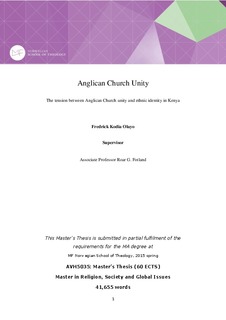Anglican Church Unity. The tension between Anglican Church unity and ethnic identity in Kenya
Master thesis
Permanent lenke
http://hdl.handle.net/11250/293729Utgivelsesdato
2015-07-28Metadata
Vis full innførselSamlinger
Sammendrag
Unity is a moral requirement in both religious and secular life. In a highly religious society, morals and values are much informed by the religious precepts. For traditional cultures, morality is by custom, and for secular cultures, morality is by reason, Moyo, quoted in Kim and Kim, (Kim and Kim, 2008, p. 66). Most African cultures today, moral issues are informed by both the religion they ascribe to, traditional culture which is still very strong and to some extend reason. The church has been accused of taking sides when a crisis arises, a time when unity is really needed. For example, during conflicts that are ethnic in nature, churches stand in solidarity with their ethnic side of affiliation. At such time Church unity sublimes into ethnic identities.
Nationwide churches like Anglican Church and Roman Catholic Church, suffer polarization along regional and ethnic lines (Kamara, 2010, p. 140). This study is about establishing the tension between Anglican Church unity and ethnic identity in Kenya. The study strives to answer the question, what is the connection between diocesan autonomy in the Anglican Church of Kenya and ethnic identity? To respond the question, a qualitative research was conducted. After choosing Mumias Diocese in Kenya as a case study, respondents were sampled by stratified purposive sampling. The data was collected by recording and note taking which were transcribed for analysis. Largely, the study revealed that as the Anglican Church continues to grow in this area, its structures at different levels are ending up in one dominant ethnic group. In some areas, they become homogeneous by composition and where there are mixed ethnic groups, the minority groups break off to form their church at different levels. The study demonstrates how the church with time is resigning into ethnic homogeneity.
